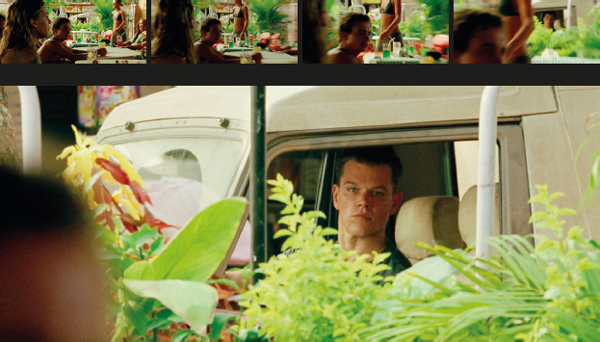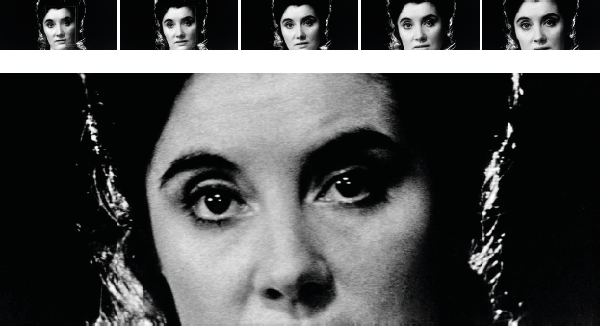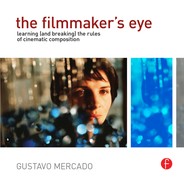zoom shot
Originally introduced to movies in the late 1950s, the zoom lens allowed, for the first time, to change a lens’ focal length while a shot is taken, letting filmmakers have a dynamic field of view without the need to move the camera or switch lenses. Although zoom shots resemble dolly shots, they differ in the way they depict space and movement. In a zoom shot, the camera remains stationary, maintaining a constant perspective as the lens zooms from wide angle to telephoto (zoom in) or from telephoto to wide angle (zoom out). In a dolly shot, the perspective does not remain constant, because the camera itself is being moved. Unlike dolly shots, where audiences feel as if they are moving toward or away from something in the frame, zoom shots make audiences feel as if an aspect of the composition is being brought toward or away from them. The primary function of a zoom shot is to change the composition of the shot as it progresses, so that it either includes previously unseen elements, or excludes already seen aspects of the composition to concentrate on a single subject. The change in focal length can be done manually, by adjusting a zoom ring on the lens itself, or with the help of a servo motor that allows an operator to control the speed at which the focal length is changed (basically mimicking the zoom switch in a video camera). The zooming action can be smooth and steady or quick and jarring, depending on the feel you want the audience to get from the shot. A frantic and unsteady change in focal length, often used while hand holding the camera in action films, showcases the means used to adjust the composition as much as the change in composition; in this case, framing errors and quick adjustments to the shot are part of the visual language of the genre and are not seen by the audience as distracting (a legacy of the documentary tradition, which introduced quick reframes using zoom lenses to catch the action in real time). Because zoom shots can radically change the framing of a shot without having to switch lenses, they often take the form of long takes (shots that last more than the average length of just a few seconds), or edited in rapid succession to create a sense of tension and danger, depending on the speed and steadiness used to change the focal length.
A classic example of a zoom shot occurs in the opening title sequence of Francis Ford Coppola’s The Conversation (1974), where a high angle extreme long shot of Union Square in San Francisco is shown while the audience hears fragments of a conversation that is obviously being secretly recorded somewhere below. The shot smoothly zooms into the square, slowly tightening the frame until it finally reveals its target: Harry Caul (Gene Hackman), a surveillance expert hired to record a conversation between a couple who might be committing adultery. The use of a slow zoom in shot, coupled with the sound of the conversation being recorded, makes the audience complicit in the act of spying, cleverly introducing one of the central themes of this film.
The opening title sequence from Francis Ford Coppola’s The Conversation (1974) marks the first use ever of an electronically controlled zoom lens in a film, with a shot that gradually reveals the central character, Harry Caul (Gene Hackman).
zoom shot

why it works
When a zoom shot changes its focal length suddenly, it can convey a sense of urgency, tension, and danger; quick adjustments to the frame, unstable compositions, and temporarily out of focus subjects are normal and expected with this style of shooting. The overall effect for the audience is that they are witnessing action as it happens, in real time, even though most of the time this is not the case. In this example from Paul Greengrass’ The Bourne Supremacy (2004), Jason Bourne (Matt Damon) has just discovered that somebody has been sent after him, prompting him to pick up his girlfriend Marie (Franka Potente) to escape the threat. The shot quickly and unsteadily zooms in (or “crash zooms”) from a composition that includes Marie in the foreground to a waiting Jason in the background, underlining the urgency and tension of this moment in the story.
technical considerations
lenses
Zoom lenses come in a variety of zoom ratios, giving you many focal length options during shooting. One thing to keep in mind is that zoom lenses have more internal elements than prime lenses (lenses with a fixed focal length), and are therefore slower, with a maximum aperture that will be significantly smaller than the maximum aperture of most high-quality prime lenses. This means you will need more light when using a zoom lens instead of a prime lens, a serious problem when shooting outdoors at night or indoors with artificial lighting. Also, unless you use a very high quality lens, the image quality of a zoom lens will be somewhat inferior to what you would get with a prime lens. A good zoom, however, can be used instead of using several primes, saving you a lot of time during production that would otherwise be spent switching lenses. If the zoom shot is taken with a static camera, an easy technique to maintain sharp focus over the range of the zoom is to first zoom all the way in to your subject and find focus (while the zoom lens is set at its longest focal length). You will then be able to zoom in or out and the subject will remain in focus throughout the shot. If the zoom shot is handheld, you will need a second person to operate the focusing ring, since the camera operator will be busy controlling the zoom ring. A follow focus attachment is indispensable in this case, since it allows a focus puller (the person controlling focus) much easier access to the focusing ring. More expensive solutions include the use of a wireless focusing system, allowing a focus puller to stand a few feet away from the action and still pull focus as needed. Follow focus attachments can also be connected to the zoom ring, letting you control how steadily the zoom is accomplished. An instance where this might be necessary, is when the zoom shot encompasses the entire zoom range of the lens. In this case, you might not be able to turn the focal length ring all the way without having to switch hands at some point, disrupting the steadiness of the zoom. Some follow focus attachments can even be adjusted so that a small turn of their knobs results in a longer turn of the zoom ring on the lens, simplifying long zooms (or focusing) tremendously.
format
Most SD and HD cameras come equipped with a native zoom lens, designed to meet the optical requirements of their electronic components. Unfortunately, the optics inherent in a zoom lens, coupled with the lower sensitivity of the typical CCD sensor, make it difficult to shoot in low-light situations without supplementary lighting. When used with a 35mm lens adapter kit, the light it cuts makes it almost imperative to have extra lights for most situations except when shooting on sunny interiors or exteriors. However, the zoom lenses found on most SD and HD cameras do have an advantage over zooms used in film. With most video cameras, you can change the focal length steadily and smoothly across the entire zoom range with a motorized servo zoom switch. In some prosumer cameras you can even select among various zoom speeds. In film cameras you cannot do this without a motorized follow focus attachment to control the zooming action, as shown in the example from Coppola’s The Conversation.
lighting
Since zoom lenses tend to be slower than primes, more lights are needed when using them than would be necessary if you were using a prime lens of the same focal length. In these cases, it becomes necessary to weigh the benefits of renting a zoom lens instead of several primes, since any money saved will be offset by the cost of having to rent extra lighting. On the other hand, a zoom can save you a lot of time during production, since you no longer need to switch lenses to change focal length.
breaking the rules

Although this shot appears to have been taken with a zoom lens, it is in fact an optically printed zoom, its magnification created not through zooming during production but with the use of an optical printer in postproduction. The telltale sign of this process is the loss of resolution and increase in graininess as the shot zooms in, an unavoidable side effect since the optical printer is simply rephotographing an already-shot piece of film. In this example, from the opening dream sequence from David Lynch’s The Elephant Man (1980), the extra graininess does not feel out of place, adding instead a stylized look to the surreal imagery that visualizes the imagined birth of the titular character.
Kagemusha. Akira Kurosawa, 1980.


